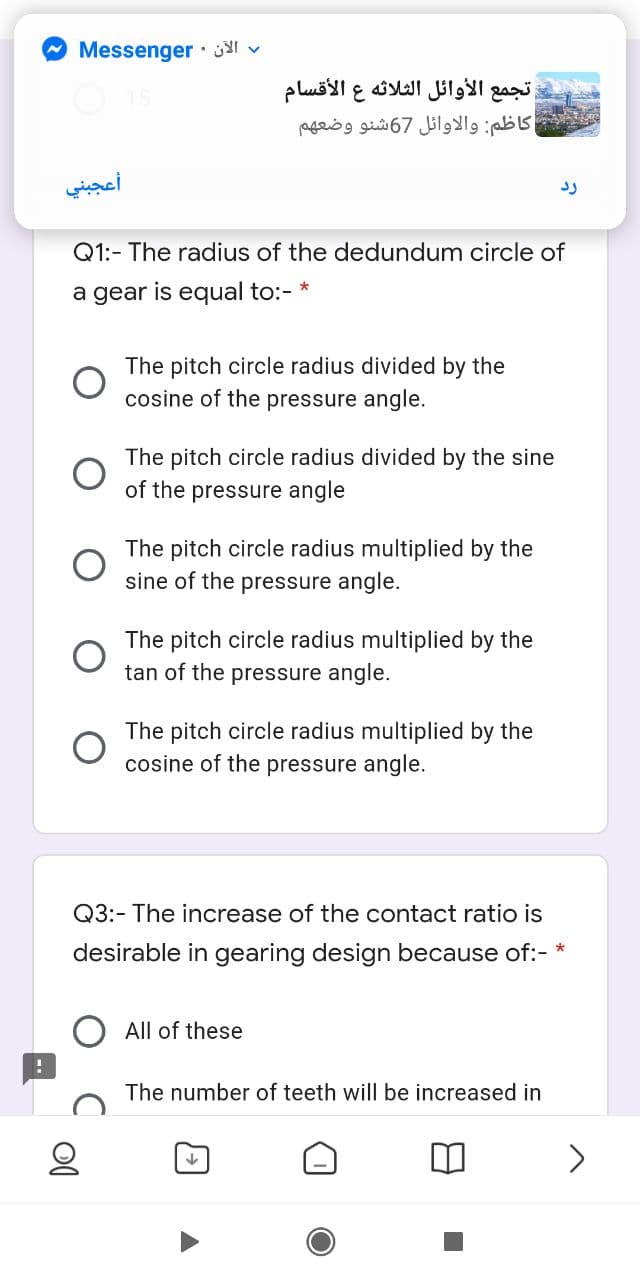Q1:- The radius of the dedundum circle of a gear is equal to:- * The pitch circle radius divided by the cosine of the pressure angle. The pitch circle radius divided by the sine of the pressure angle The pitch circle radius multiplied by the sine of the pressure angle. The pitch circle radius multiplied by the tan of the pressure angle. The pitch circle radius multiplied by the cosine of the pressure angle.
Q1:- The radius of the dedundum circle of a gear is equal to:- * The pitch circle radius divided by the cosine of the pressure angle. The pitch circle radius divided by the sine of the pressure angle The pitch circle radius multiplied by the sine of the pressure angle. The pitch circle radius multiplied by the tan of the pressure angle. The pitch circle radius multiplied by the cosine of the pressure angle.
International Edition---engineering Mechanics: Statics, 4th Edition
4th Edition
ISBN:9781305501607
Author:Andrew Pytel And Jaan Kiusalaas
Publisher:Andrew Pytel And Jaan Kiusalaas
Chapter7: Dry Friction
Section: Chapter Questions
Problem 7.61P
Related questions
Question

Transcribed Image Text:W Messenger 1 v
تجمع الأوائل الثلاثه ع الأقسام
كاظم: والأوائل 67شنو وضعهم
أعجبني
Q1:- The radius of the dedundum circle of
a gear is equal to:- *
The pitch circle radius divided by the
cosine of the pressure angle.
The pitch circle radius divided by the sine
of the pressure angle
The pitch circle radius multiplied by the
sine of the pressure angle.
The pitch circle radius multiplied by the
tan of the pressure angle.
The pitch circle radius multiplied by the
cosine of the pressure angle.
Q3:- The increase of the contact ratio is
desirable in gearing design because of:- *
All of these
The number of teeth will be increased in
Expert Solution
This question has been solved!
Explore an expertly crafted, step-by-step solution for a thorough understanding of key concepts.
Step by step
Solved in 2 steps

Knowledge Booster
Learn more about
Need a deep-dive on the concept behind this application? Look no further. Learn more about this topic, mechanical-engineering and related others by exploring similar questions and additional content below.Recommended textbooks for you

International Edition---engineering Mechanics: St…
Mechanical Engineering
ISBN:
9781305501607
Author:
Andrew Pytel And Jaan Kiusalaas
Publisher:
CENGAGE L

International Edition---engineering Mechanics: St…
Mechanical Engineering
ISBN:
9781305501607
Author:
Andrew Pytel And Jaan Kiusalaas
Publisher:
CENGAGE L